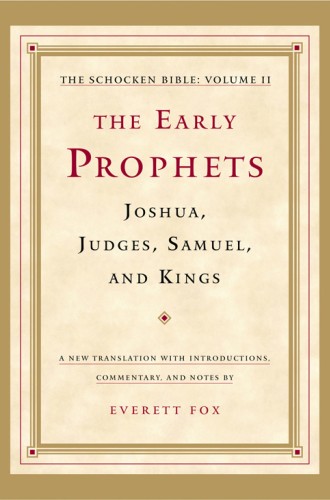Found in translation
George Steiner, in a learned article on translation and hermeneutics, once asserted, “The translator invades, extracts, and brings home.” He recognizes that translation is not simply rendering a passage from one language into another, but is a matter of shaping and determining the world into which the reader enters. In this remarkable volume of translation, Everett Fox of Clark University has done all that Steiner proposes. He has invaded our common assumptions about the Bible, extracted accents and cadences, and brought the text home to us in fresh and compelling ways.
The volume is a continuation of Fox’s prodigious project of translation known as The Schocken Bible. He has already completed the five books of the Torah, and in this volume takes up the “former Prophets” of the Hebrew canon that in Christian parlance are dubbed historical books. Along with fresh translation, Fox offers succinct notes of commentary that are well informed by current scholarship and consistently take a commonsense balanced position.
Read our latest issue or browse back issues.
Fox clearly lays out his intention for the translation. A century ago Martin Buber and Franz Rosenzweig rendered the Hebrew Bible into German. Their aim was to attend to the sounds of the text for oral reading, so that the German would be informed by the cadences of the Hebrew text. Fox stands in that tradition. Indeed, his teacher at Brandeis, Nahum Glatzer, was a graduate assistant to Rosenzweig in the last days of the latter’s life, so there is a self-conscious continuity from Buber and Rosenzweig to the present work. More than that, Buber’s famous attention to the dialogic is reflected in this translation, for Fox understands that translation is not a once-and-for-all accomplishment, but an ongoing dialogic enterprise between text and reader. Fox explains: “To what is on the printed page you will have to add your own voice and your own struggles. . . . that mandate of entering into the spirit of the text as a part of the dialogue is still very much the point of translating the Bible.”
Keeping a close eye on particular performances of the text, Fox writes that he is “constantly seduced by the earthiness and directness of biblical Hebrew.” That earthiness and directness are evident in his translation. Thus his work will provide a lively script for the performance of the text in Jewish and Christian communities of faith. As we know from good music, every performance is a new translation, and that is certainly what Fox intends in this work.
Fox weaves his way carefully between an assumption of historicity (with frequent notes of historical parallels) and recognition that the text is a “prototype” or “paradigm” that serves later generations that rely on the legitimating authority of “old tradition” for contemporary identity and faith. Fox does not press the issue of historicity, but the alert reader will see that he intends much more than simple historicity. Indeed, he judges that what we have is “metahistory,” or “history with an attitude.”
In the book of Joshua, Fox recognizes that at face value the text reports on a “genocide” in which Israel seeks to obliterate the resident population. But he sees beyond that and observes that the text is designed to serve as a legacy for later generations of displaced people. While the land, in Deuteronomic perspective, is given conditionally, the text, in its precision, serves as something of a real estate deed for subsequent generations.
One is struck by the spacing of the text. The normally margin-to-margin prose text is broken up so that the appearance of the page suggests poetry designed for oral reading. Also, Fox has a keen ear for pattern and repetition. Thus, in Joshua 21:13–19, we get pasture land 14 times, in a regular cadence. Fox likely would note that 14 is twice the perfect seven. In 22:30–34 we get children repeatedly, with a mix of children of Israel and children of x (various specific tribes). The lines serve as a patterned performance that is missed in most translations.
Fox avers that in the book of Judges violence is voiced in the service of political and religious themes. The book raises for him the question, Why does the God of Israel still stand by this people? The answer is in the divine promise that leads to the ongoing “resiliency of Israel.” But that end is accomplished by vigorous poetic imagination. In the encounter of Eglon and Ehud (chapter 3), Fox notes that the narrative is laden with subtle sexual allusion, a way to minimize a powerful enemy. In 3:22, with the murder of Eglon, Fox translates, “the feces came out.” The NRSV translates “the dirt came out” and notes that the Hebrew is “uncertain.” Of course, our attention will be focused on the Song of Deborah in Judges 5, which Fox likens to the much memorized “Paul Revere’s Ride” by Longfellow, a piece of lore remote from historicity. Fox ponders the imagery of the death of Sisera at the hands of Jael, whom he describes as a “nurturing mother, potential or actual lover, and finally, of course, gruesome killer.” The final word of verse 27, which NRSV has as dead, he offers as ravished.
In the books of Samuel, Fox explores the character of David, who is both “in control and out of control.” He pays particular attention to the body parts—heart and head—that not only characterize the specific characters, but also suggest the “inherent sickness of the Israelite body politic.” Thus, as Barbara Green has proposed, the personal narratives function as parables for the narrative of Israel as well. Fox notes the multiple ways in which heart is used as a key word, though it is usually rendered in common usage in ways that hide its pervasiveness.
Fox offers a translation of the oral exchanges between Eli and Samuel and between Samuel and the elders of Bethlehem in Hemingway-like terseness. The procession of the sons of Jesse before Samuel is vivid in ways that will make oral performance striking. In 1 Samuel 17:23 the usual characterization of Goliath as “champion” is here rendered as “the Man of the Space-Between”—a phrase that is faithful to the text.
In the books of Kings, Fox takes Solomon as a paradigmatic embodiment of Israel; both king and Israel are “the glorious and the regrettable.” Fox notes that in 1 Kings 10 the Hebrew letter shin, the first letter of “Solomon,” is used frequently, suggesting that the queen is “overwhelmed by King Shelomo and his accomplishments.” The rapid-fire exchange between Bathsheba and Adonijah (1 Kings 2) is opportunity for more terse dialogue. In the contest at Mount Carmel (1 Kings 18), Fox translates the usual “limp along with two different opinions” as “hop on two branches.” He translates the euphemism of “turned aside” in 18:27 with a much more daring figure of “doing his business.” He concludes his account of Kings with the judgment that Israel is left “in a kind of limbo”: “In any event, with the end of the book, Israel embarks on centuries of control by others or other forces (Babylonians, Persians, Greeks, and Romans) which would lead ultimately to both a wider exile and the creation of the Hebrew Bible in its final form.” This judgment readily links “exile” and “final form.”
This book of translation is an immense accomplishment and a huge gift for those who care about the performance of scripture in community. The work of translation is slow and hard, and Fox is to be celebrated for his singular achievement. Engagement with this book will require readers to ready themselves for work that is slow and hard. The gains of such an effort will be immense and specific, but it will allow for no skimming or summary. The work is sound by sound and word by word. It is the sound of faith that is knowing, empowering, ironic, and summoning.






